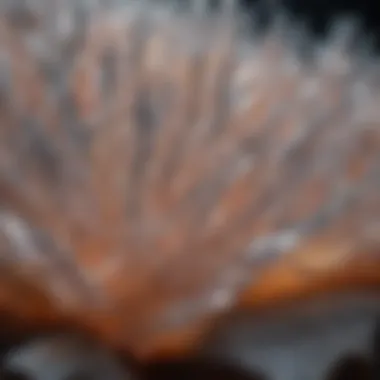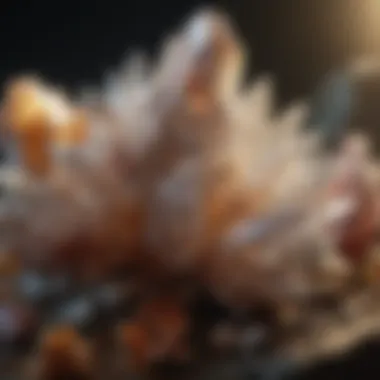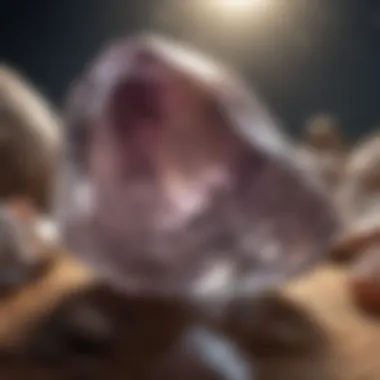Unveiling the Enigma of Crystals: A Guide to Identifying Crystal Rocks


Rock and Fossil Identification
In the realm of crystal exploration, having a keen eye for distinguishing between ordinary rocks and the exquisite allure of crystals is essential. To identify if a rock truly embodies crystalline characteristics, one must first grasp the fundamental disparities between the two entities. Rocks, comprising various minerals and textures, differ from crystals, which possess a distinct geometric structure with well-defined faces, angles, and luster. When examining a specimen, discerning features like transparency, cleavage, and crystal form can provide valuable clues to ascertain if it is indeed a crystal.
Understanding the types of rocks and fossils is paramount in advancing one's proficiency in rock identification. Different rocks, such as igneous, sedimentary, and metamorphic, exhibit unique properties that aid in their classification. Equipping oneself with knowledge about these rock categories enables a more systematic approach to differentiating crystals from their non-crystalline counterparts. Furthermore, recognizing key characteristics like color, hardness, and streak can serve as crucial indicators in the identification process. Utilizing tools like magnifying lenses, hardness picks, and streak plates can enhance the accuracy and precision of rock and crystal identification.
Collecting Tips and Techniques
When venturing into the realm of crystal collection, adopting best practices ensures a fruitful and enriching experience. Practitioners in the field often emphasize the significance of conducting thorough research to discover prime collecting sites teeming with geological treasures. Geological maps and online resources can be valuable assets in pinpointing locations abundant in crystalline specimens. Additionally, mastering the art of safely extracting specimens from their natural habitats is vital to preserve the integrity of the crystals while minimizing environmental impact.
Exploring preservation and display methods is integral in safeguarding and showcasing collected rocks and crystals effectively. Implementing techniques such as encapsulation, labeling, and using archival materials aids in maintaining the physical integrity of specimens over time. Adhering to proper storage practices, such as storing delicate crystals in padded containers to prevent damage, ensures longevity and protects the aesthetic appeal of the collection. Moreover, exploring creative display ideas, such as utilizing shadow boxes or lighted showcases, adds a touch of elegance and sophistication to the exhibition of geological wonders.
Geological Insights
Embarking on a journey to decipher the mysteries of crystals unveils profound insights into geological formations and processes. Delving into the historical significance of rocks and fossils sheds light on the evolution of the Earth and the intricate interplay of natural forces that have shaped its terrain. Exploring notable discoveries in the field provides a glimpse into groundbreaking findings that have revolutionized our understanding of geology. By unraveling the geological mysteries encapsulated within crystals, enthusiasts can uncover a treasure trove of knowledge that transcends time and enriches their appreciation of the Earth's diverse and awe-inspiring geology.
Introduction to Crystals and Their Significance
In this section, we embark on a captivating journey into the realm of crystals, shedding light on their profound significance. Crystals hold immense value in various fields, from spirituality to science, making it imperative to comprehend their essence. By understanding the molecular structure and metaphysical properties of crystals, enthusiasts can enrich their exploration of these geological wonders. This segment serves as a cornerstone laying the foundation for deciphering the mysteries of crystals and identifying them within rocks.
Exploring the Intriguing Realm of Crystals
Definition and Formation of Crystals:
Exploring the essence of crystals begins with unraveling their precise definition and the intricate process of their formation. The formation of crystals involves the systematic arrangement of atoms or molecules, resulting in distinct geometric shapes. This structured arrangement grants crystals their unique properties such as symmetry and clarity, distinguishing them from other rock formations. Delving into the definition and genesis of crystals unveils a world governed by precision and order, offering enthusiasts a glimpse into the sublime nature of these mineral formations.
Historical Significance of Crystals:
Tracing back through history, crystals have played momentous roles in various cultures and belief systems. Ancient civilizations revered crystals for their purported healing properties and spiritual significance, attributing mystical powers to these crystalline structures. From the mystical lore of Atlantis to the ritualistic practices of Mayan priests, the historical tapestry of crystals is rich and diverse. Understanding the historical significance of crystals provides a holistic perspective on their enduring allure and profound influence on human civilization.


Variety of Crystal Types:
The world of crystals encompasses a vast array of types, each with its distinct characteristics and properties. From luminous quartz crystals to dazzling amethyst clusters, the variety within crystal formations is awe-inspiring. Different crystal types exhibit varied colors, transparencies, and energetic vibrations, enabling enthusiasts to explore a kaleidoscope of geological treasures. Familiarizing oneself with the diversity of crystal types enhances the appreciation for the intricate beauty and geological complexity inherent in these natural marvels.
Importance of Identifying Crystals in Rocks
In this section, we delve into the pivotal significance of recognizing crystals within rock formations, shedding light on the benefits and implications of this discernment. Identifying crystals serves as a gateway to unlocking the geological mysteries concealed within rocks, offering insights into the Earth's composition and history.
Value of Crystals in Collecting and Scientific Research:
The value of crystals extends beyond their aesthetic appeal, playing a crucial role in both collecting and scientific research endeavors. Crystal collectors seek out specimens for their rarity and intrinsic beauty, curating magnificent displays that showcase the diversity of crystal formations. In scientific research, crystals serve as valuable specimens for studying geological processes, mineral formations, and even atomic structures, providing researchers with invaluable data for various fields of study.
Aesthetics and Geological Significance:
Beyond their scientific importance, crystals offer aesthetic value that captivates the senses and elevates the beauty of rock specimens. The vibrant hues, unique forms, and iridescent lusters of crystals add a visually enchanting dimension to geological collections. Moreover, the geological significance of crystals lies in revealing the environmental conditions under which they formed, offering clues to the Earth's past climates and tectonic activities. Recognizing the aesthetics and geological implications of crystals enhances enthusiasts' appreciation for these multifaceted gems.
Physical Characteristics of Crystals
Crystals possess unique physical characteristics that play a crucial role in identifying and understanding them. By examining the structure, transparency, color, and luster of crystals, enthusiasts can unravel the mysteries hidden within these geological treasures. The physical properties of crystals not only contribute to their aesthetic appeal but also provide valuable insights into their formation processes and geological significance.
Crystal Structure and Symmetry
Atomic Arrangement in Crystals
Atomic arrangement in crystals refers to the specific order in which atoms are packed together within the crystal lattice. This arrangement determines the crystal's distinct properties, such as its hardness, cleavage, and behavior under different conditions. Understanding the atomic arrangement is essential for differentiating between various crystal types and comprehending their unique characteristics.
Symmetry Properties
Symmetry properties in crystals encompass the geometric patterns and symmetrical structures that define their overall shape and form. Crystals exhibit symmetry along different axes, reflecting their internal organization and symmetry elements. By analyzing symmetry properties, enthusiasts can identify crystal systems, planes, and axes, offering valuable clues to their mineral composition and crystallographic features.


Transparency, Color, and Luster
Impact of Light on Crystals
The interaction of light with crystals influences their transparency and optical properties. By observing how light traverses through crystals, enthusiasts can determine their level of transparency, refractive index, and internal reflections. Understanding the impact of light helps in distinguishing between transparent, translucent, and opaque crystals based on their light-absorbing or light-transmitting capabilities.
Color Variations and Impurities
Color variations in crystals stem from different factors, including elemental impurities, structural defects, and crystal lattice substitutions. These variations give rise to a diverse range of colors and shades in crystals, adding to their visual appeal and distinctiveness. Analyzing color variations provides insights into a crystal's chemical composition, origin, and environmental influences.
Distinctive Luster Types
The luster of a crystal refers to its surface appearance and the way it reflects light. Crystals exhibit various luster types, such as metallic, vitreous, pearly, or greasy, based on their specific mineral properties and crystal structures. Identifying the distinctive luster of a crystal can aid in mineral identification, as different minerals exhibit characteristic luster types that align with their mineralogical classification.
Identifying Crystals in Rocks
In this segment of the article, we delve into the crucial aspect of Identifying Crystals in Rocks. Understanding and recognizing crystals within rocks holds significant importance in the realm of geology and mineralogy. By identifying crystals, enthusiasts can unravel the geological history and formation processes encapsulated within rocks. This section aims to equip rock and fossil collectors with the essential knowledge and tools to distinguish between regular rocks and those containing precious crystalline formations. Recognizing crystals enhances the value of a rock collection, providing valuable insights into the earth's composition and geological significance.
Rocks vs. Crystals: Understanding the Differences
Composition and Structure Variances
When differentiating between rocks and crystals, one key aspect to focus on is the Composition and Structure Variances. Rocks are composed of various minerals that form intricate structures with diverse compositions. In contrast, crystals exhibit a highly organized atomic structure, showcasing a repeating pattern that contributes to their unique properties. Understanding these variances is crucial in accurately identifying crystals within rocks. The distinctive composition and structure of crystals set them apart from ordinary rock formations, highlighting the importance of recognizing these differences in geological studies and collection practices.
Visual Clues for Crystal Detection
Visual clues play a pivotal role in the detection of crystals within rocks. Crystals often display specific characteristics that distinguish them from surrounding minerals and rock matrices. Observing the presence of geometric shapes, well-defined edges, and distinctive color patterns can be indicative of crystalline structures within rocks. By paying close attention to these visual cues, collectors and researchers can efficiently identify crystals and appreciate their aesthetic and geological significance. Leveraging visual clues is instrumental in honing the skill of crystal identification and enriching one's understanding of the diverse world of minerals.
Key Steps in Identifying Crystals


Observation and Inspection Techniques
Observation and Inspection Techniques form the foundation of crystal identification. By meticulously observing a rock specimen, collectors can unveil subtle details that indicate the presence of crystals. Inspecting the color, transparency, and surface features of a rock aids in differentiating between common rock types and crystal-bearing specimens. These techniques empower enthusiasts to enhance their collection with unique and precious crystal specimens, fostering a deeper appreciation for the earth's mineral diversity.
Physical and Chemical Tests
Conducting Physical and Chemical Tests serves as a crucial step in crystal identification. By subjecting a rock sample to tests such as hardness evaluation, streak analysis, and acid reactions, collectors can gather valuable data on the mineral composition and crystal content of the specimen. These tests provide conclusive evidence of crystal presence, aiding in accurate identification and classification of rocks. Utilizing physical and chemical tests elevates the level of precision in crystal identification, enabling enthusiasts to build a well-informed mineral collection.
Utilizing Specialized Tools
The utilization of specialized tools enhances the accuracy and efficiency of crystal identification processes. Tools such as magnifying lenses, ultraviolet lights, and hardness testing kits enable collectors to assess minute details and properties that might go unnoticed with the naked eye. By employing these instruments, enthusiasts can delve deeper into the world of crystals, unraveling their microscopic features and unique characteristics. The use of specialized tools elevates the standards of crystal identification, enriching the experience of rock and fossil collectors.
Common Misconceptions About Crystal Identification
Confusion with Other Mineral Types
A common misconception in crystal identification involves confusion with other mineral types. Certain minerals share visual similarities with crystals, leading to misinterpretations and erroneous identifications. Overcoming this misconception requires a keen understanding of crystal attributes and distinct mineral properties. By honing observational skills and expanding mineralogical knowledge, collectors can avoid mislabeling specimens and accurately differentiate between crystals and related mineral varieties.
Misinterpretation of Crystal Forms
Misinterpretation of Crystal Forms poses a challenge in accurate identification practices. The diverse array of crystal shapes and structures can sometimes lead to misinterpretations regarding crystal classifications. To address this issue, collectors must familiarize themselves with crystal geometries, growth patterns, and cleavage characteristics. By gaining in-depth knowledge of crystal forms, enthusiasts can navigate through potential misinterpretations and enhance their proficiency in crystal identification techniques, showcasing a heightened level of expertise in the field of mineralogy.
Conclusion: Unveiling the Beauty of Crystal Diversity
In this final section of the article, we embark on a journey to unravel the mesmerizing allure of crystal diversity. Understanding the beauty and significance of various crystal types adds a profound layer to our exploration of geological wonders. By unveiling the unique characteristics of crystals, we gain a deeper appreciation for the natural complexities and marvels within rocks and minerals. The essence of crystal diversity lies in its ability to showcase a captivating array of formations, colors, and properties, representing a testament to the incredible diversity of our planet's geology. This section aims to encapsulate the essence of crystal diversity and inspire a newfound admiration for these remarkable geological treasures.
Appreciating the Splendor of Crystals
Eclectic Nature of Crystal Varieties
The eclectic nature of crystal varieties forms the bedrock of our fascination with these geological marvels. Each crystal type brings forth a distinct personality, manifested through its unique atomic structure, color variations, and transparency levels. This diversity enriches our understanding of geological compositions and ignites a sense of curiosity about the Earth's intricate formations. The eclectic nature of crystal varieties serves as a testament to the immense beauty and complexity found in nature, offering a treasure trove of exploration for enthusiasts and researchers alike. Embracing this diversity broadens our perspective on crystals and deepens our connection to the geological tapestry of our planet.
Endless Fascination with Geological Treasures
The endless fascination with geological treasures epitomizes our enduring intrigue with the mysteries of the Earth. Crystals, as geological treasures, hold a magnetic allure that transcends time and space, captivating generations with their enchanting beauty. The intrinsic connection between humans and geological treasures speaks to a shared fascination with the unknown and the uncharted territories of our planet. This enduring fascination serves as a driving force behind scientific discoveries, aesthetic pursuits, and a profound appreciation for the exquisite formations that nature bestows upon us. Delving into the world of geological treasures unveils a realm of boundless wonder and endless fascination, inviting us to explore, learn, and marvel at the kaleidoscope of crystal diversity that surrounds us.







